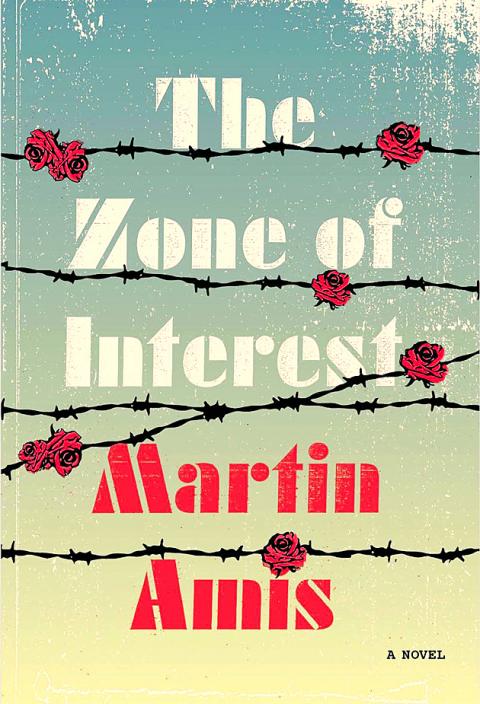It’s difficult to understand why Martin Amis’ longtime French and German publishers rejected his latest novel, The Zone of Interest.
A dark satire that takes place mainly in Kat Zet — the same fictional branch of Auschwitz featured in the author’s gimmicky 1991 novel, Time’s Arrow — Zone creates a chilling sense of the banality of evil by depicting Nazis as petty bureaucrats in office cubicles, who chatter away about their work in the breezy, self-absorbed tones of characters in, say, the comic strip Dilbert or television’s The Office.
Although this approach to the subject may initially feel disturbingly irreverent, it seems clear that Amis wants to use this narrative strategy as a means of jolting the reader into a new understanding of how what one character calls “such a methodical, such a pedantic and such a literal exploration of the bestial” could take hold in “‘a sleepy country of poets and dreamers.’” And while Zone bogs down in the middle, it builds to a haunting conclusion that slams home the horror of the Holocaust.

Since the philosopher Theodor Adorno warned, shortly after the war, of the dangers of making art out of the Holocaust (“through aesthetic principles or stylization,” he argued, “the unimaginable ordeal” is “transfigured and stripped of some of its horror”), a vast array of novels, movies, plays and even graphic novels (Art Spiegelman’s Maus) have taken on the subject. For that matter, The Zone of Interest is not all that daring. It’s certainly not the first work of art to use satire or extreme stylization to try to grapple with the Nazis’ radical evil: Lina Wertmuller’s movie Seven Beauties juxtaposed the monstrous with the comic to unnerve the viewer, while Hans-Jurgen Syberberg’s experimental seven-hour-plus film, Our Hitler, employed puppetry, cabaret turns and surreal imagery to try to convey the Fuhrer’s power and the nightmarish world that was Nazi Germany.
That the renowned French house of Gallimard declined to publish Zone — reportedly on the grounds, in the words of his editor there, that the novel “wasn’t very convincing” — is all the more perplexing when the reader recalls that some years ago France bestowed its most prestigious literary award, the Prix Goncourt (as well as a prize from the Academie Francaise), on Jonathan Littell’s willfully sensational and deliberately repellent novel, The Kindly Ones. That novel is told from the point of view of an unrepentant Nazi and dwells, voyeuristically and perversely, for more than 900 pages on scenes in which Jews are tortured, mutilated and gassed, intercutting them with the narrator’s incestuous and sadomasochistic fantasies.
There is plenty of grossness in Zone, too, but Amis uses his longtime fascination with bodily functions and the grotesque (expended in his earliest novels on descriptions of sex and adolescent repulsiveness) to give the reader a stomach-turning awareness of the abominations the Nazis inflicted on their victims. Most powerful is his insistent dwelling on the stench that emanated from the camp: “the outright putrefaction of the meadow and the pyre,” the odor of “cardboard with wet rot” that rose from the smokestacks, and “the funk of hunger — the acids and gases of thwarted digestion, with a urinous undertang.”
Most of Zone is told from the point of view of three central characters. One is Paul Doll, the camp’s put-upon, self-pitying commandant, who complains about the outrageous schedules of prisoner transports he’s being asked by superiors to accept (as if “I didn’t have ‘enough on my plate’”), and who daydreams, while attending theater, about “how long it would take (given the high ceiling as against the humid conditions) to gas the audience.”
Then, there’s Golo Thomsen, a nephew of Martin Bormann (Hitler’s private secretary) and veteran womanizer, who falls in love with Doll’s zaftig wife, Hannah. And, finally, there’s Szmul, a member of the Sonderkommando, “the saddest men in the history of the world” — prisoners forced to assist in the disposal of bodies in the crematorium and gas chambers — who observes that nightmares “are incapable of coming up with anything even remotely as terrible as what I do all day.”
Szmul serves as the moral conscience of this book, and the sections narrated by him underscore the horror of what is really going on at Kat Zet, beneath the other characters’ jabber about cost-efficiency, hitting their numbers and figuring out “ergonomically” proper means of taking care of business.
Throughout his career, Amis has been highly attuned to language, and by making the Nazis in this novel speak in the chatty tones of American millennials (with a few dashes of British aristo condescension), he makes us hyper-aware of the supreme ordinariness of their evil. What holds Thomsen’s attention at the camp, he writes, “were not the men in stripes, as they queued or scurried in lines,” but “the figures in city business suits, designers, engineers, administrators from IG Farben plants in Frankfurt, Leverkusen, Ludwigshafen, with leather-bound notebooks and retractable yellow measuring tapes, daintily picking their way past the bodies of the wounded, the unconscious and the dead.”
Amis has grappled with the atrocities of the 20th century before. (He wrote about Stalin’s slave labor camps in the misguided Koba the Dread and the deeply affecting House of Meetings.) In this case, the reader sometimes feels that Amis is being overly self-conscious about what he’s up to. And he makes obvious points, again and again, about his Nazi bureaucrats’ appalling obliviousness to the crimes against humanity they are helping to commit — or, at the very least, enabling. One exchange between Thomsen and his friend Boris goes: “Would you agree that we couldn’t treat them any worse?” Reply: “Oh, come on. We don’t eat them.” Another character says: “Treating the work force as disposable, Mr. Thomsen, is hugely counterproductive. My God, those Kapos! What’s the matter with them?”
The Zone, however, has a rolling, cumulative power. Its conclusion is oddly reminiscent of the end of the great Carol Reed movie The Third Man. By that point in his novel, Amis has not only extracted genuine emotion from the relationship between Hannah and Thomsen, but he’s also given us a harrowing take on the monstrousness of the Nazis’ crimes.

In the next few months tough decisions will need to be made by the Taiwan People’s Party (TPP) and their pan-blue allies in the Chinese Nationalist Party (KMT). It will reveal just how real their alliance is with actual power at stake. Party founder Ko Wen-je (柯文哲) faced these tough questions, which we explored in part one of this series, “Ko Wen-je, the KMT’s prickly ally,” (Aug. 16, page 12). Ko was open to cooperation, but on his terms. He openly fretted about being “swallowed up” by the KMT, and was keenly aware of the experience of the People’s First Party

Aug. 25 to Aug. 31 Although Mr. Lin (林) had been married to his Japanese wife for a decade, their union was never legally recognized — and even their daughter was officially deemed illegitimate. During the first half of Japanese rule in Taiwan, only marriages between Japanese men and Taiwanese women were valid, unless the Taiwanese husband formally joined a Japanese household. In 1920, Lin took his frustrations directly to the Ministry of Home Affairs: “Since Japan took possession of Taiwan, we have obeyed the government’s directives and committed ourselves to breaking old Qing-era customs. Yet ... our marriages remain unrecognized,

During the Metal Ages, prior to the arrival of the Dutch and Chinese, a great shift took place in indigenous material culture. Glass and agate beads, introduced after 400BC, completely replaced Taiwanese nephrite (jade) as the ornamental materials of choice, anthropologist Liu Jiun-Yu (劉俊昱) of the University of Washington wrote in a 2023 article. He added of the island’s modern indigenous peoples: “They are the descendants of prehistoric Formosans but have no nephrite-using cultures.” Moderns squint at that dynamic era of trade and cultural change through the mutually supporting lenses of later settler-colonialism and imperial power, which treated the indigenous as

Standing on top of a small mountain, Kim Seung-ho gazes out over an expanse of paddy fields glowing in their autumn gold, the ripening grains swaying gently in the wind. In the distance, North Korea stretches beyond the horizon. “It’s so peaceful,” says the director of the DMZ Ecology Research Institute. “Over there, it used to be an artillery range, but since they stopped firing, the nature has become so beautiful.” The land before him is the demilitarized zone, or DMZ, a strip of land that runs across the Korean peninsula, dividing North and South Korea roughly along the 38th parallel north. This